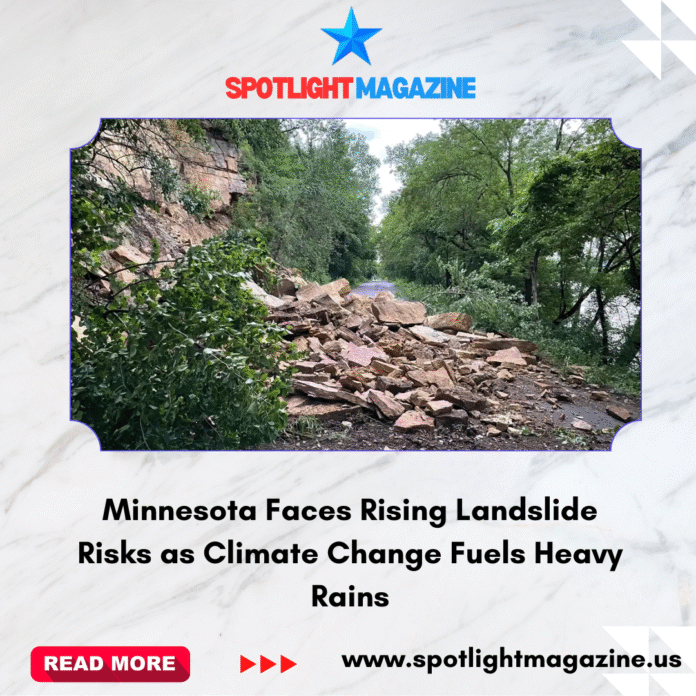Heavier rainfall fueled by a warming climate is accelerating erosion across Minnesota, leading to more frequent landslides, mudslides, and rockfalls. These events damage homes, businesses, and roads, and at times, have turned deadly. The sandstone bluffs and hillsides of the Minnesota River Valley are especially at risk.
On a foggy afternoon in North Mankato, public works director Luke Arnold drove along Judson Bottom Road, a narrow stretch wedged between the Minnesota River and a towering bluff. Rockfalls are common there, and city crews clear debris every couple of weeks. Arnold worries that one day, a larger rockfall could strike at the wrong time, endangering dog-walkers, cyclists, or drivers.
In July 2024, heavy rains triggered a rockfall that forced the closure of Judson Bottom Road for several weeks. The city council asked residents whether the road should be closed permanently, but 62 percent opposed the idea, urging officials to repair and reopen it. This isn’t the first time closure has been debated. After similar rockfalls in 2019, the council also considered shutting it down but eventually reopened it. Now, the city has launched a geotechnical study to assess risks on Judson Bottom Road and nearby Lookout Drive, which sits above the bluff.
The risks are not just hypothetical. In December 2023, a Minnesota State University, Mankato student, Jack Loso, was killed in a landslide while hiking in Minneopa State Park. His family is suing the state, arguing that officials should have warned visitors of the danger. A decade earlier, two children were killed in a landslide at a riverside park in St. Paul. These tragedies have intensified efforts by scientists to better understand what makes slopes fail and how to prevent future loss of life.
Phil Larson, an earth science director at Minnesota State University, Mankato, and Andrew Wickert, a professor at the University of Minnesota, are working together to re-map landslide-prone areas of the Minnesota River Valley. One site of concern is State Highway 68 near Courtland, where a massive landslide in 2018 buried the road and even created a temporary lake when the hillside rotated downward. Today, large nets drape over the slope to catch debris, while new vegetation helps stabilize the soil.
Larson and Wickert’s research focuses on how rainfall affects soil composition and stability. Heavy downpours saturate the ground, weakening its strength until slopes eventually give way. “One of the main drivers of these failures are these high-magnitude precipitation events,” Larson explained. Identifying the tipping point where hillsides collapse is crucial for predicting risks and helping local leaders prepare.
Their work isn’t only about gathering data for scientists and engineers. Wickert says the findings should also be shared with residents and decision-makers who live and work near vulnerable areas. Having clear information and strategies in place could prevent confusion and save lives when future slides occur. “Instead of reacting in panic, communities can have a plan before anything happens,” he said.
For Larson, the research carries personal weight. He lives in Mankato and was shaken by the death of the student at Minneopa State Park. That tragedy pushed him to redouble his efforts. “We don’t want to see anybody hurt,” he said. “We can give a lot to understanding how these systems work to help communities move forward.”
As climate change drives heavier rainfall, Minnesota’s bluffs and valleys will face increasing pressure. For those who live near them, the challenge is not only to protect property but to ensure that lives are not lost to the natural beauty that surrounds them.


